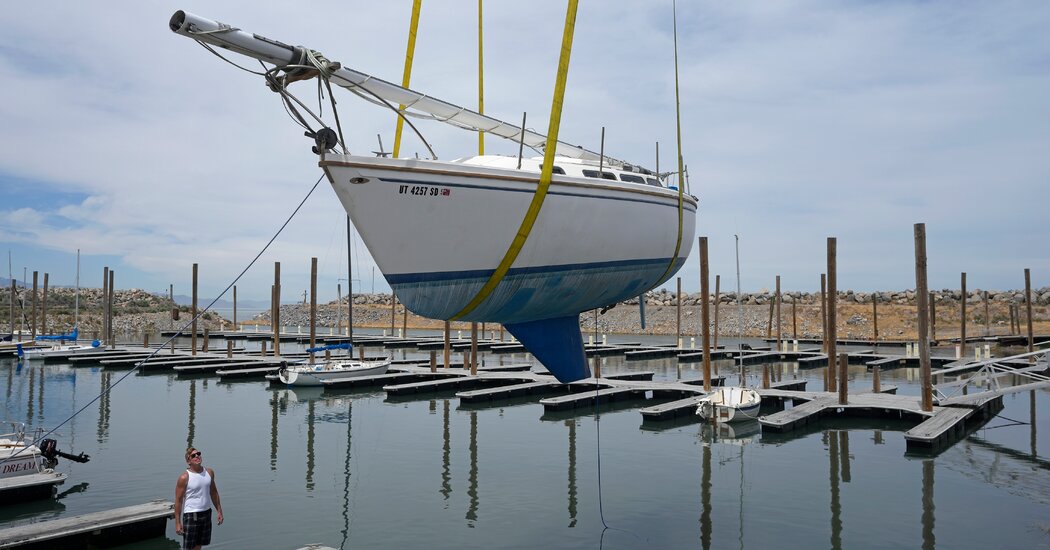Two years ago, the Great Salt Lake became an omen for the risks of climate change: The water level dropped to a record low, threatening the ecosystem, economy and even the air quality of the area around Salt Lake City, home to a majority of Utah’s population.
Now, after two unusually wet winters and a series of conservation measures, the lake has gained about six feet. Despite that increase the lake is still below the minimum levels considered healthy. And environmentalists and policymakers are concerned that the increase might reduce the pressure to save the lake.
“I worry about complacency,” said Bonnie Baxter, director of the Great Salt Lake Institute at Westminster University. “We need to really be cautious about being optimistic.”
Increased water levels in the lake are primarily the result of higher-than-normal snowfall, according to Hayden Mahan, a meteorologist with the National Weather Service in Salt Lake City.
Last year, Utah received more than double its typical snowfall, the most since records began in 1981. This year, snowfall was 30 percent above average. But there’s no reason to expect those above-average levels of snowfall to persist, he said.
And the increase in water levels is uneven, Mr. Hayden said. The levels have increased in the southern part of the lake, home to the state’s economically important brine shrimp industry while the northern half remains closer to its record lows.
The water level is likely to fall about three feet this summer, as heat increases evaporation, Dr. Baxter said. Experts have been concerned that as water levels drop and the lake bed is exposed, wind storms could carry arsenic from the bottom of the lake into the air, threatening the health of nearby residents, who make up three-quarters of Utah’s population. For years, snowmelt that feeds the lake has been diverted for use by farmers and residents.
The fact that the Great Salt Lake is no longer at record lows threatens to weaken political support for more conservation measures, Dr. Baxter said. As an example, she said state lawmakers passed fewer bills this year aimed at reducing water use by farmers or cities.
“There’s less legislative action when we’re getting more water,” Dr. Baxter said.
Zachary Frankel, executive director of the Utah Rivers Council, an environmental group, said he worries that the public is losing a sense of urgency regarding the lake.
The council sells rain barrels, which help homeowners use less municipal water. In the spring of 2022 and 2023, when public awareness of the lake’s predicament was at its height, the group sold about 3,000 rain barrels, Mr. Frankel said. This spring, it has sold just 1,700.
“When we’re in dry years, people change their behavior,” Mr. Frankel said. “In wet years they do not.”
Municipal water use in Salt Lake City fell between 2022 and 2023, according to Laura Briefer, director of the Department of Public Utilities for Salt Lake City. But that decline stalled this year, with water use so far about the same as in 2023, she said.
Ms. Briefer cautioned that it can be dangerous to conclude too much based on a single year. But she, too, is worried. “I share the concern about Great Salt Lake fatigue,” Ms. Briefer said. “I am concerned that we might lose sight of the broader, long-term problems.”
Joel Ferry, executive director for Utah’s Department of Natural Resources, said that changes in the past two years in public attitude and government action could sustain the lake over time.
Conservation laws passed during the last two years require time to take effect, but stand to reduce water usage significantly, Mr. Ferry said. They include state subsidies for farmers who install more efficient irrigation systems.
Just as important, he said, is that farmers have begun to embrace the idea that conserving water is good for their business. “It takes time,” Mr. Ferry said. “But they are coming around.”
That doesn’t mean there isn’t still more to do, Mr. Ferry said.
“Complacency is a huge concern of mine,” he said. “We are pushing as hard as we can.”
